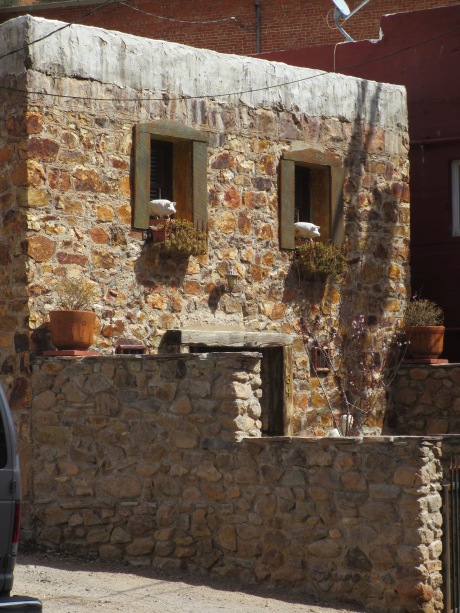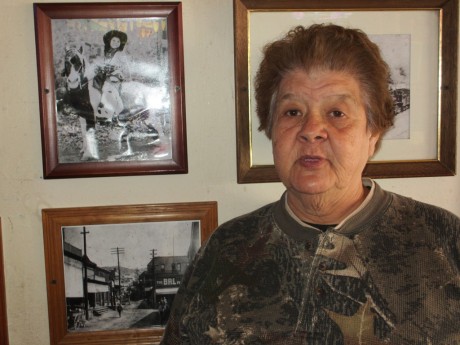
Three days ago, we visited Bisbee, Arizona. Copper mining was the economical force in Bisbee from 1880 to 1975. In producing copper, the mines also brought up gold, silver, lead, zinc, and magnesium which doesn’t account for the beautiful and colorful minerals appreciated by rock hounds all over the world.

I don’t know what they do with giant pits after the riches of the ground are removed, but the area around the Copper Queen Mine is colorful to drive by. The mine itself is available to tour, though we chose not to go. I’ve been on mine tours before and Jim doesn’t like to face 51 degrees for two hours.

The Historical Society Museum in town covered the mining operations very well and was very interesting. They don’t allow pictures in their museum, but some of the same photos are available from other sources. Mining equipment out front gives you look into the old style of hard rock mining.

They sent men down in these cages with candles and a lunch bucket. It was moist and cold; full of rats. The men didn’t kill the rats because if the rats vacated the mine, they knew the gas had reached dangerous levels. It was their signal to get out.

The main brewery in town sits at the head of Brewery Gulch and is still a brewery today. A 1906 Tuscon newspaper described brewery gulch as such: The street is somewhat frightful from a sanitary point of view. It is covered in slime several inches deep and about four feet wide from which come a nauseating odor …it remains a disgrace to the city.

We teased Casey,from Kansas, the bartender, who served us a good IPA and a brautwurst. The brewery also has a unique lime flavored beer that I liked. I got a taste, I didn’t drink more than one brew, just in case you suspect me of being a hard drinker.

We poked around town. Interesting old buildings are everywhere, like this triangular building. The streets are hilly; there is much to see and do. A person could easily spend two days exploring Bisbee. Keep that in mind when you go.

A rare sight, a Young Women’s Christian Association. We saw one in Douglas, as well. They were most likely needed in these rough western towns full of hard-working, swearing, fighting, swilling, gambling, tobacco chewing men.

I’d like a stairway just like this, except I don’t have a place to put it.

The elegant old Copper Queen Hotel is still in business.

The Copper Queen dining room.

And the bar with the traditional nude painting popular in those days. No self-respecting woman ever entered these doors. Now, the bartender is a woman.

Now why didn’t I think to put cute little piggies in my windows?

I wouldn’t want a giant fly over my door, but, hey. If you have a business, this one certainly attracts your attention.

When we arrived in Bisbee, we had planned to stay at a VFW instead of Belle Starr’s Ranch. There I discovered a microbrewery. It wasn’t open for lunch, and the VFW was not a suitable place to park. I was determined to find Electric Beer before we left town, and I did.

They serve it at the oldest bar in town, St. Elmos. Here we met Frances, an Indian woman who was born and raised in Bisbee and her picture was on the wall on her pony as a child. The place is loaded with pictures. The three women we talked with told us it was the friendliest and best hang-out in town where the locals get their brewskis.

I quizzed this guy about his tattoos. He said he has thousands of dollars invested in his body art. He took off his shirt and let me photograph him. He has a fabulous olive oil tasting bar, really posh and beautifully decorated with great art work. Nice place to stop.

I’ve painted the Bisbee miners as hard-drinking,gambling men, etc. But they were family men too, just earning a living with the brute strength of their bodies, with no health care and very little safety in the mines. It was hard, often crippling work. They had formed a union and asked for two men on an ore car, no blasting while men were in the mine, non-discrimination, and other safe working conditions. They were flatly refused and voted to go on strike. The mine owners contacted Federal authorities to put a stop to this strike. When refused, they met with Sheriff Wheeler who put out posters to gather a possee for 1,200 men who were told they were putting down an insurgency. It was the largest possee ever assembled. What the mine owners did was establish a group of vigilantes. They hauled the miner’s out of their homes and gathered them in a baseball field. One man resisted and was killed. They were beaten and questioned and if someone could vouch for their non-union participation, they were allowed to return to their homes and jobs. The rest, about 1,300 of them, were loaded onto train cars, without food, water or money and taken on a 16 hour ride and dumped in the desert. This happened in America the land of the free. I was astounded. A part of history I had never heard before. A reporter followed the train and got them help from the Sheriff of the neighboring county who gathered them up, set up tents for them, and gave them three months to do whatever it took to get their lives back in order. Not much happened to the mine owners or the sheriff. To read an account of this deportation check the link below:
http://www.library.arizona.edu/exhibits/bisbee/history/overview.html
http://en.wikipedia.org/wiki/Bisbee_Deportation
hermes birkin
ReplyDeletemoncler jackets
kevin durant shoes
kobe basketball shoes
golden goose superstar
golden goose mid star
coach outlet store
coach bags sale
golden goose outlet
michael kors outlet